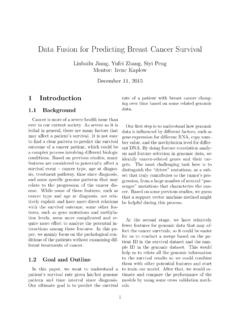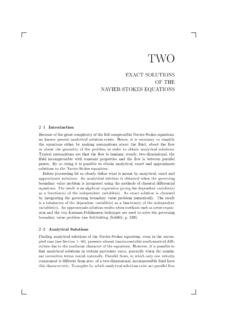Transcription of arXiv:1201.4145v2 [cs.SI] 28 Feb 2012
1 The Role of Social Networks in Information DiffusionEytan Bakshy Facebook1601 Willow Park, CA RosennFacebook1601 Willow Park, CA MarlowFacebook1601 Willow Park, CA AdamicUniversity of Michigan105 S. State Arbor, MI social networking technologies enable individuals tosimultaneously share information with any number of the causal effect of these mediums on the dis-semination of information requires not only identificationof who influences whom, but also of whether individualswould still propagate information in the absence of social sig-nals about that information. We examine the role of socialnetworks in online information diffusion with a large-scalefield experiment that randomizes exposure to signals aboutfriends information sharing among 253 million subjects insitu.
2 Those who are exposed are significantly more likely tospread information, and do so sooner than those who arenot exposed. We further examine the relative role of strongand weak ties in information propagation. We show that,although stronger ties are individually more influential, itis the more abundant weak ties who are responsible for thepropagation of novel information. This suggests that weakties may play a more dominant role in the dissemination ofinformation online than currently and Subject [Models and Principles]: User/Machine Systems; [Social and Behavioral Sciences]: SociologyGeneral TermsExperimentation, Measurement, Human FactorsKeywordssocial influence, tie strength, causality1.
3 INTRODUCTIONS ocial influence can play a crucial role in a range of behav-ioral phenomena, from the dissemination of information, tothe adoption of political opinions and technologies [23, 42],which are increasingly mediated through online systems [17, Part of this research was performed while the author wasa student at the University of version. Copyright is held by the International World Wide WebConference Committee (IW3C2). Distribution of these papers is limited toclassroom use, and personal use by 2012 , April 16 20, 2012 , Lyon, 978-1-4503-1229-5/12 ]. Despite the wide availability of data from online socialnetworks, identifying influence remains a challenge.
4 Indi-viduals tend to engage in similar activities as their peers, soit is often impossible to determine from observational datawhether a correlation between two individuals behaviors ex-ists because they are similar or because one person s behav-ior has influenced the other [5, 32, 39]. In the context ofinformation diffusion, two people may disseminate the sameinformation as each other because they possess the same in-formation sources, such as web sites or television, that theyconsume regularly [3, 38].Moreover, homophily the tendency of individuals withsimilar characteristics to associate with one another [1, 28,34] creates difficulties for measuring the relative role ofstrong and weak ties in information diffusion, since peo-ple are more similar to those with whom they interact of-ten [22, 34].
5 On one hand, pairs of individuals who interactmore often have greater opportunity to influence one an-other and have more aligned interests, increasing the chancesof contagion [11, 27]. However, this commonality ampli-fies the potential for confounds: those who interact moreoften are more likely to have increasingly similar informa-tion sources. As a result, inferences made from observa-tional data may overstate the importance of strong ties ininformation spread. Conversely, individuals who interactinfrequently have more diverse social networks that provideaccess to novel information [12, 22]. But because contactbetween such ties is intermittent, and the individuals tendto be dissimilar, any particular piece of information is lesslikely to flow across weak ties [14, 37].
6 Historical attempts tocollect data on how often pairs of individuals communicateand where they get their information have been prone tobiases [10, 33], further obscuring the empirical relationshipbetween tie strength and factors related to homophily can be addressedusing controlled experiments, but experimental work hasthus far been confined to the spread of highly specific in-formation within limited populations [6, 13]. In order tounderstand how information spreads in a real-world envi-ronment, we wish to examine a setting where a large pop-ulation of individuals frequently exchange information withtheir peers. Facebook is the most widely used social net-working service in the world, with over 800 million peopleusing the service each month.
7 For example, in the UnitedStates, 54% of adult Internet users are on Facebook [26]. [ ] 28 Feb 2012 Those American users on average maintain 48% of their realworld contacts on the site [26], and many of these individualsregularly exchange news items with their contacts [38]. Inaddition, interaction among users is well correlated with self-reported intimacy [18]. Thus, Facebook represents a broadonline population of individuals whose online personal net-works reflect their real-world connections, making it an idealenvironment to study information use an experimental approach on Facebook to mea-sure the spread of information sharing behaviors. The ex-periment randomizes whether individuals are exposed viaFacebook to information about their friends sharing behav-ior, thereby devising two worlds under which informationspreads: one in which certain information can only be ac-quired external to Facebook, and another in which informa-tion can be acquired within or external to Facebook.
8 Bycomparing the behavior of individuals within these two con-ditions, we can determine the causal effect of the mediumon information remainder of this paper is organized as follows. Wefurther motivate our study with additional related work inSection 2. Our experimental design is described in Section , in Section 4 we discuss the causal effect of exposureto content on the newsfeed, and how friends sharing behav-ior is correlated in time, irrespective of social influence viathe newsfeed. Furthermore, we show that multiple sharingfriends are predictive of sharing behavior regardless of expo-sure on the feed, and that additional friends do indeed havean increasing causal effect on the propensity to share.
9 InSection 5 we discuss how tie strength relates to influence andinformation diffusion. We show that users are more likelyto have the same information sources as their close friends,and that simultaneously, these close friends are more likelyto influence subjects. Using the empirical distribution of tiestrength in the network, we go on to compute the overalleffect of strong and weak ties on the spread of informationin the network. Finally, we discuss the implications of ourwork in Section RELATED WORKO nline networks are focused on sharing information, andas such, have been studied extensively in the context of in-formation diffusion. Diffusion and influence have been mod-eled in blogs [2, 20, 25], email [31], and sites such as Twitter,Digg, and Flickr [8, 21, 29].
10 One particularly salient charac-teristic of diffusion behavior is the correlation between thenumber of friends engaging in a behavior and the proba-bility of adopting the behavior. This relationship has beenobserved in many online contexts, from the joining of Live-Journal groups [7], to the bookmarking of photos [15], andthe adoption of user-created content [9]. However, as Anag-nostopoulos, et al. [4] point out, individuals may be morelikely to exhibit the same behavior as their friends becauseof homophily rather than as a result of peer influence. Sta-tistical techniques such as permutation tests and matchedsampling [5] help control for confounds, but ultimately can-not resolve this fundamental problem [39].
![arXiv:0706.3639v1 [cs.AI] 25 Jun 2007](/cache/preview/4/1/3/9/3/1/4/b/thumb-4139314b93ef86b7b4c2d05ebcc88e46.jpg)

![arXiv:1301.3781v3 [cs.CL] 7 Sep 2013](/cache/preview/4/d/5/0/4/3/4/0/thumb-4d504340120163c0bdf3f4678d8d217f.jpg)
![@google.com arXiv:1609.03499v2 [cs.SD] 19 Sep 2016](/cache/preview/c/3/4/9/4/6/9/b/thumb-c349469b499107d21e221f2ac908f8b2.jpg)












